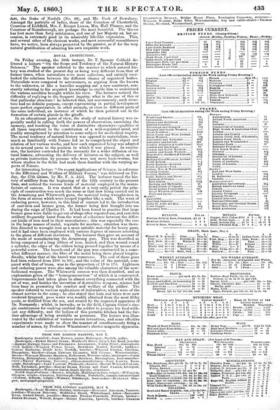BOYAL INSTITUTION.
On Friday evening, the 20th instant, Dr. T. Spencer Cobbold de- livered a lecture " On the Scope and Tendency of the Natural-History Sciences." The speaker referred to the manner in which natural his- tory was studied at the present day as being very different from that of former times, when naturalists were mere collectors, and entirely over- looked the relations between the different classes of organized bodies. Naturalists were compared to astronomers, as arguing from the known to the unknown, or like a traveller mapping out a new continent, con- stantly referring to his acquired knowledge to enable him to understand the various novelties brought within his view. The lecturer noticed the difficulty of replying to the frequent inquiry, what is the use of this or that particular structure ? he believed that, not uncommonly, such struc- ture had no definite purpose, except representing in partial development more perfect organization in other animals, or even in different parts of the same individual, an instance of which he then pointed out in the formation of certain glands in the giraffe.
In an educational point of view, the study of natural history was es- pecially useful in calling forth the powers of observation, exercising the memory, and teaching the value of distinctive characters-qualities at all times important to the constitution of a well-regulated mind, and readily strengthened by attention to some subject for methodical inquiry. The moral tendency of natural history was opposed to materialism, inas- much as familiarity with Nature led us to comprehend the object and relation of her various works, and how each organized being was adapted in its several parts to the position in which it was placed. In conclu- sion, the lecturer contended for the necessity for a wider diffusion of na- tural history, advocating the delivery of lectures on the subject, as well as private instruction by persons who were not mere book-worms, but whose studies in the fields had made them familiar with the varying as- pects of Nature. An interesting lecture " On recent Applications of Science, in reference to the Efficiency and Welfare of Military Forces," was delivered on Fri- day, the 27th ultimo, by Mr. F. A. Abel. The lecturer traced the his- tory of artillery from the beginning of the 12th century to the present time, and noticed the various kinds of material employed in the manu- facture of cannon. It was stated that at .a very early. period the prin- ciple of construction was much the same as that now being carried out in the Armstrong and Whitworth guns, the material being wrought-iron in the form of staves which were hooped together like a cask. The want of enduring power, however, in this kind of cannon led to the introduction of cast-iron and bronze guns, the former being first brought into use during the reign of Charles II. It had been found in practice that large bronze guns were liable to get out of shape after repeated use, and cast-iron artillery frequently burst from the want of coherence between the differ- ent kinds of iron used in their manufacture; this was especially the ease in the large masses of metal, requisite for mortars ; attention was there- fore directed to wrought iron as a more suitable material for heavy guns, and it had since been employed with various degrees of success according to the plans of different inventors. The lecturer then gave an account of the mode of manufacturing the Armstrong gun. This was described as being composed of a long ribbon of iron, heated, and than wound round a cylinder, the edges of the ribbon being pressed together by means of a powerful screw. The breech-end of the gun was constructed in a some- what different manner, the'fibre of the metal being there placed longitu- dinally, whilst that of the barrel was transverse. The cost of these guns had been reduced from 2501. to 931., and the value of the material, com- pared with that of brass, was in the proportion of 19 to 175. Lightness and enduring power were also among the valuable characters of the new- fashioned weapon. The Whitworth cannon was then described, and an explanation given of the " homogeneous iron " of which it is constructed. Improvements had taken place in almost everything connected with the art of war, and besides-the invention of destructive weapons, science had been busy in promoting the comfort and welfare of the soldier. The speaker referred to various applications of indiarubber, which were of the utmost service in the camp ; he also stated that huts and tents were now rendered fireproof, pure water was readily obtained from the most filthy pools; or distilled from the sea, and ;grated by the improved apparatus of Dr. Normandy; whilst, in barracks, or in the field, Captain Grant's sim- ple contrivances for cooking enabled the soldier to prepare his food with- out any-difficulty, and the boilers of this portable kitchen had the fur- ther advantage of being available as pontoons. The lecture was illus- trated by the exhibition of 'various recent inventions, and some effective earperiments were made to show the manner of simultaneously firing a number of mines, by Professor Wheatatone's'electro•magnetio apparatus.


























 Previous page
Previous page